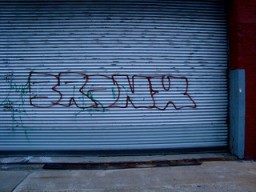
Interesting article in The New York Times Magazine (an installment of Adam Davidson’s always-interesting economics column) about the Bronx economy and why it hasn’t prospered in recent years like parts of Brooklyn.
Why has Brooklyn gentrified and experienced “phenomenal economic growth” while the Bronx continues to be known for “unemployment and rampant prostitution”? Why do “nearly a third of [Bronx] residents over age 25 lack a high-school diploma”?
Davidson argues that housing stock has a lot to do with it:
Brooklyn and Queens were once collections of independent towns whose homegrown economies were rooted in Long Island agriculture, not Manhattan mercantilism. Local elites built expensive town houses on tree-lined streets. These neighborhoods fell on hard times during the 1970s, but their expensive stock was perfectly positioned for revitalization as the Manhattan boom of the past few decades pushed young professionals across the river. The Bronx, however, never developed its own economic drivers. It became, by the late 19th century, a haven for immigrants attracted to (but unable to afford) Manhattan. The borough developed far fewer wealthy areas, and many neighborhoods became devoted to less-gentrifiable housing units.
All this means that not only are upwardly mobile people not moving in, but the current residents make their money and largely do business transactions (a.k.a spend money and fuel the economy) in Manhattan, not the Bronx.
The Brownstoner blog adds a relevant statistic that Davidson left out:
The NYC Landmarks Preservation Commission has designated 29 Historic Districts in Brooklyn and only 11 in the Bronx. Landmarking is largely responsible for preserving large swaths of attractive housing stock in Brooklyn during tougher times and for preventing the construction of “less-gentrifiable housing units.”
Obviously, improving the local economy should not rely on the investments of gentrifiers and inevitable displacement of low-income and working-class people. What about improving the lot for people who already live in the Bronx?
Bronx Borough President Ruben Diaz Jr. is attempting to spur local jobs by building “an indoor mall that could bring 2,000 construction jobs and 1,700 permanent positions.” He’s also hoping to lure a developer to build a luxury hotel near Yankee Stadium so travelers crash there instead of in Manhattan.
One piece missing from this argument is that even Brooklyn’s economic development is piecemeal. Areas like East New York and Brownsville continue to struggle and aren’t seeing the median income level in their neighborhoods rise. Indeed, as Brownstoner points out, “Brooklyn’s recent boom has been a rising tide that has not lifted all boats.” Let’s hope that the Bronx model doesn’t replicate the disparities.
Leave a comment